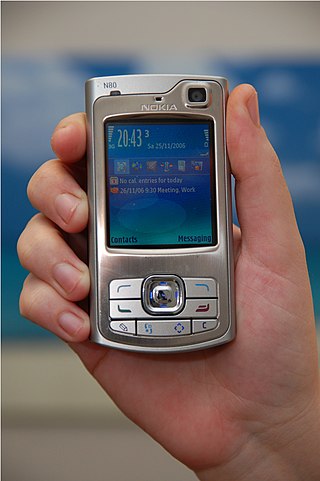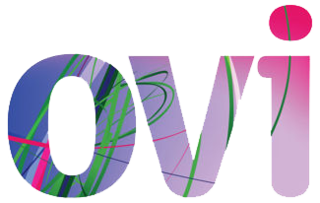Symbian Ltd. was a software development and licensing consortium company, known for the Symbian operating system (OS), for smartphones and some related devices. Its headquarters were in Southwark, London, England, with other offices opened in Cambridge, Sweden, Silicon Valley, Japan, India, China, South Korea, and Australia.

The Nokia 7610 is a Symbian OS mobile phone introduced at CEBIT on 18 March 2004. It features a 1 megapixel camera with a design similar to 2003's Nokia 7600. It went on sale with a list price of €500 and came with a 64 MB MMC card. It runs on Nokia's Series 60 platform. It was marketed as a stylish and imaging device, and allowed direct Bluetooth photo printing. End-users can also use the 7610 with Nokia Lifeblog. Other pre-installed applications include the Opera Mobile web browser, RealPlayer and Kodak Photo Sharing.

The Nokia 6600 is a mobile phone introduced on 16 June 2003 by Nokia, costing approximately €600 when released in October 2003. It was part of Nokia's high-end model of the 6xxx Classic Business Series. It runs on Symbian OS 7.0s. It also featured a VGA camera, a music player and video player, Bluetooth and a memory card slot, being the second non-Communicator to do so.

The Nokia 6680 is a high-end 3G mobile phone running Symbian operating system, with Series 60 2nd Edition user interface. It was announced on 14 February 2005, and was released the next month. The 6680 was Nokia's first device with a front camera, and was specifically marketed for video calling. It was also Nokia's first with a camera flash. It was the forerunner of the Nseries, which was released in April 2005; its successor being the N70.

The Nokia N70 is a 3G mobile phone from Nokia. It was announced as part of the Nokia's new line of multimedia smartphones, the Nseries, on 27 April 2005. It started shipping in September 2005. It runs on the S60 2nd Edition, Feature Pack 3 on Symbian v8.1 operating system. It was succeeded by the Nokia N73. The N70 was popular and sold well.

Vertu is a manufacturer and retailer of luxury handmade mobile phones, established in 1998 and formerly owned by Finnish mobile phone manufacturer Nokia. Previously located in the UK, ownership of the brand is now contested between two entities located in Hong Kong and France.

The Nokia N80 is a 3G mobile phone from Nokia announced on November 2, 2005, part of the multimedia Nseries line. It runs on Symbian OS v9.1 and the S60 3rd Edition interface. It was first released in June 2006.

The Nokia 6300 is a mobile telephone handset produced by Nokia. It was announced on 28 November 2006 and released in January 2007. This model was assembled in several factories, including Jucu plant, near Cluj, in Romania.

Ovi by Nokia was the brand for Nokia's Internet services. The Ovi services could be used from a mobile device, computer or via the web. Nokia focused on five key service areas: Games, Maps, Media, Messaging and Music. Nokia's aim with Ovi was to include third party developers, such as operators and third-party services like Yahoo's Flickr photo site. With the announcement of Ovi Maps Player API, Nokia started to evolve their services into a platform, enabling third parties to make use of Nokia's Ovi services.

The Open Handset Alliance (OHA) is a consortium of 84 firms to develop open standards for mobile devices. Member firms include HTC, Sony, Dell, Intel, Motorola, Qualcomm, Texas Instruments, Google, Samsung Electronics, LG Electronics, T-Mobile, Nvidia, and Wind River Systems.
The Nokia 7650 is a 2.5G consumer-oriented mobile phone belonging to the fashion and experimental (7xxx) series. It was introduced in Barcelona on 19 November 2001, and was described by CEO Jorma Ollila as the company's most important launch of that year.

The Samsung G810 is a Symbian OS mobile phone developed and released by Samsung Telecommunications. It was announced at Mobile World Congress on 11 February 2008.

The Symbian Foundation was a non-profit organisation that stewarded the Symbian operating system for mobile phones which previously had been owned and licensed by Symbian Ltd. Symbian Foundation never directly developed the platform, but evangelised, co-ordinated and ensured compatibility. It also provided key services to its members and the community such as collecting, building and distributing Symbian source code. During its time it competed against the Open Handset Alliance and the LiMo Foundation.

The Nokia N97 is a high-end smartphone introduced on 2 December 2008 by telecommunications manufacturer Nokia as part of its Nseries and released in June 2009 as the successor to the Nokia N96 phone. The N97 was Nokia's second S60-based touchscreen phone, after the Nokia 5800 XpressMusic. The device featured slide-out QWERTY keyboard, and ran on the Symbian v9.4 operating system. Its design took cues from the Nokia N79. A smaller and lower-cost variant, the Nokia N97 mini, was later released.

Symbian is a discontinued mobile operating system (OS) and computing platform designed for smartphones. It was originally developed as a proprietary software OS for personal digital assistants in 1998 by the Symbian Ltd. consortium. Symbian OS is a descendant of Psion's EPOC, and was released exclusively on ARM processors, although an unreleased x86 port existed. Symbian was used by many major mobile phone brands, like Samsung, Motorola, Sony Ericsson, and above all by Nokia. It was also prevalent in Japan by brands including Fujitsu, Sharp and Mitsubishi. As a pioneer that established the smartphone industry, it was the most popular smartphone OS on a worldwide average until the end of 2010, at a time when smartphones were in limited use, when it was overtaken by iOS and Android. It was notably less popular in North America.

The Nokia C6-00 is a smartphone and portable entertainment handheld cellular device by Finnish communications company Nokia, running the Symbian S60v5 operating system. It was announced on April 13, 2010. It is the third Nokia Symbian^1 smartphone featuring a full slide-out QWERTY keyboard. Its software and hardware specifications resemble the N97 mini in most ways. One of the differences is that the sliding in this phone is flat, unlike the upward angled in the N97 mini, hence allowing a four row QWERTY keypad, bringing a slightly enhanced typing experience to the table. The phone has a 5-megapixel camera, though unlike the N97 mini, it does not have Carl Zeiss optics. It also has a secondary camera in front for video calls. The Nokia C6-01 is the successor to the C6-00 featuring a major step-up with the new Symbian^3 operating system, Ovi Maps 3.0 and such but losing the QWERTY keyboard.

The Nokia C7-00 is a smartphone from the Nokia Cseries. It was introduced on 14 September 2010 and released in Q4 2010. The C7-00 features a 3.5-inch (89 mm), 640 x 360 pixel capacitive touchscreen and features 720p video recording, and was also the world's first smartphone to have NFC capability. Nokia's mobile phone business head Anssi Vanjoki called it the "sleekest" device in the world. Unlike the Nokia N8 flagship, the C7 has physical call and hangup buttons.
Nokia's strategic nomenclature can be traced back in 2005 when the Nseries line was launched, offering devices with flagship specifications and premium hardware at various price points. These devices were considered the "bread and butter" of the company and were often positioned to showcase their latest technologies. Thanks to the newfound consumer and enterprise interest in smartphones at the time, the company introduced four additional collections to diversify their product portfolio and meet demands in most market segments. These new phone series were named Eseries, targeting small business and enterprise customers; Xseries, providing consumer-grade multimedia-focused devices; Cseries, which Nokia used to target both the low-end and mid-range market segments; and Tseries, for devices exclusive to the Chinese market.
The Nokia N77 is a 3G mobile phhone from Nokia, introduced on 12 February 2007 and released in June 2007. It runs on Symbian 9.1. The N77's specs were somewhat basic compared with most Nseries devices at the time, but it included a DVB-H television tuner. As stated in Nokia's press release, the N77 was designed as a low-cost mobile TV to accelerate DVB-H adoption. Sporting a candybar design similar to the N73, it was the company's second DVB-H device after the N92, though it did have a smaller screen. The N77 was thus only available in limited DVB-H markets and are now hard to come by.
The Nokia 3-digit series are a series of feature and smartphones by HMD Global and previously by Microsoft Mobile and Nokia, generally aimed at developing markets.














